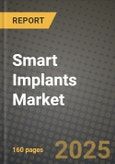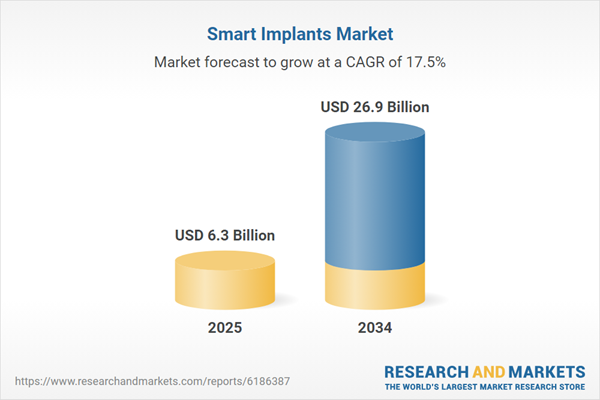The smart implants market is rapidly transforming the landscape of medical devices by integrating sensors, wireless communication, and data analytics into traditional implants. These devices go beyond structural support or replacement - they actively monitor physiological conditions, transmit data in real time, and even respond dynamically to changes in the body. Smart implants are most commonly used in orthopedics, cardiology, and dental applications, where continuous tracking of healing, stress, pressure, or bio-signals can enhance treatment outcomes and reduce complications. With rising demand for personalized medicine and value-based healthcare, smart implants offer a proactive approach to post-operative care and chronic disease management. Their ability to generate actionable data also aids clinicians in early intervention, minimizing hospital readmissions and long-term costs. As the global healthcare system continues to shift toward remote monitoring and digital therapeutics, smart implants represent a key convergence point between biotechnology and connectivity, offering a path forward in predictive and patient-centered medicine.
The smart implants market saw momentum driven by regulatory clearances, expanded R&D investments, and cross-sector partnerships between medtech firms and technology providers. Orthopedic smart implants, particularly knee and hip replacements with embedded motion sensors, gained traction as they allowed surgeons to track healing progress and implant performance remotely. Cardiovascular implants with telemetry functions also gained approval in various markets, offering real-time data on heart rhythms, pressures, and blood flow, greatly aiding in the management of heart failure and arrhythmias. Dental smart implants featuring microchips capable of monitoring jawbone integration and oral health metrics entered early commercial phases. Meanwhile, advancements in biocompatible materials and low-energy chip design allowed for longer implant life spans and safer patient experiences. Hospitals and surgeons began incorporating data from smart implants into electronic health records (EHRs) to inform clinical decision-making. Alongside this progress, health insurers began exploring reimbursement models for implant-generated data, reflecting the growing recognition of their clinical value.
The smart implants market is expected to evolve into a critical pillar of intelligent, personalized healthcare delivery. Developments will focus on multi-sensor integration - where implants can simultaneously track mechanical stress, temperature, biochemical signals, and healing indicators - to offer a more holistic view of patient recovery. AI and machine learning algorithms will be embedded within implant ecosystems to flag anomalies and suggest interventions, enabling a shift from reactive to preventative care. Wireless charging and energy-harvesting technologies will improve implant longevity, reducing the need for battery replacements or surgical updates. Interoperability with wearable devices and digital twins will allow healthcare providers to simulate and optimize care in virtual environments before applying them in real life. However, the pace of adoption will hinge on navigating data ownership, cybersecurity, and clinical validation concerns. As healthcare becomes increasingly connected, smart implants will play a vital role in bridging the gap between surgery, recovery, and long-term health maintenance.
Key Insights: Smart Implants Market
- Integration of Multi-Sensor Capabilities: Smart implants are evolving to include various sensors that monitor mechanical load, temperature, and chemical biomarkers simultaneously, enabling more detailed patient monitoring and early detection of complications post-surgery.
- Expansion into Dental and Spinal Applications: Beyond orthopedics and cardiology, smart implants are gaining ground in dental and spinal procedures, where real-time data can help track bone integration, implant stability, and nerve interactions.
- Adoption of AI-Enhanced Analytics in Implants: Advanced smart implants are leveraging AI to analyze patient-specific data, predict risks, and enable faster clinical decision-making - improving outcomes through predictive, rather than reactive, care.
- Development of Battery-Free and Energy-Harvesting Designs: New power solutions such as inductive charging and biomechanical energy harvesting are extending implant lifespans and reducing the need for surgical battery replacements.
- Increased Interoperability with EHR and Wearables: Smart implants are being designed to integrate with electronic health records and consumer health devices, creating a continuous, real-time feedback loop between patients and healthcare providers.
- Rising Prevalence of Chronic and Degenerative Diseases: An aging population and increasing rates of conditions such as arthritis, osteoporosis, and cardiovascular disease are fueling the demand for implants that offer continuous, personalized monitoring.
- Shift Toward Remote Monitoring and Post-Acute Care: Healthcare providers are embracing technologies that reduce hospital stays and support remote patient management, with smart implants enabling this transition through continuous in-body data collection.
- Advancements in Biocompatible and Microelectronic Technologies: Innovations in material science and miniaturization are making it easier to develop safe, reliable smart implants with longer lifespans and improved patient comfort.
- Supportive Reimbursement and Regulatory Environment: Growing acknowledgment by insurers and regulators of the clinical value of smart implants is encouraging adoption by healthcare institutions and physicians.
- Data Privacy and Security Risks in Connected Implants: With implants transmitting sensitive health information wirelessly, there are heightened concerns over data breaches, unauthorized access, and cybersecurity threats, requiring rigorous encryption and regulatory safeguards to ensure patient trust and safety.
Smart Implants Market Segmentation
By Type
- Orthopedic Implants
- Cardiovascular Implants
- Dental Implants
- Cosmetic Implants
- Other Types
By Surgery
- Open Surgery
- Minimally Invasive Surgery
By Application
- Knee and Hip Arthroplasty
- Spine Fusion
- Stents
- Intraocular Lens
- Pacing Devices
By End-User
- Hospitals
- Ambulatory Surgical Centers
- Specialty Clinics
- Other End-Users
Key Companies Analysed
- Johnson & Johnson Services Inc.
- Abbott Laboratories
- Medtronic plc
- Stryker
- Boston Scientific Corporation
- Zimmer Biomet
- Terumo Corporation
- Smith & Nephew plc
- Biotronik
- Integra LifeSciences
- Cochlear Ltd.
- CONMED Corporation
- Globus Medical Inc.
- Penumbra Inc.
- Orthofix Medical Inc.
- Nevro Corp.
- Exactech Inc.
- IQ IMPLANTS USA
- Senseonics
- Canary Medical Inc.
- Aleva Neurotherapeutics SA
- Intelligent Implants
- Rejoint srl
- DirectSync Surgical
- Smart Implant Solutions
Smart Implants Market Analytics
The report employs rigorous tools, including Porter’s Five Forces, value chain mapping, and scenario-based modeling, to assess supply-demand dynamics. Cross-sector influences from parent, derived, and substitute markets are evaluated to identify risks and opportunities. Trade and pricing analytics provide an up-to-date view of international flows, including leading exporters, importers, and regional price trends.Macroeconomic indicators, policy frameworks such as carbon pricing and energy security strategies, and evolving consumer behavior are considered in forecasting scenarios. Recent deal flows, partnerships, and technology innovations are incorporated to assess their impact on future market performance.
Smart Implants Market Competitive Intelligence
The competitive landscape is mapped through proprietary frameworks, profiling leading companies with details on business models, product portfolios, financial performance, and strategic initiatives. Key developments such as mergers & acquisitions, technology collaborations, investment inflows, and regional expansions are analyzed for their competitive impact. The report also identifies emerging players and innovative startups contributing to market disruption.Regional insights highlight the most promising investment destinations, regulatory landscapes, and evolving partnerships across energy and industrial corridors.
Countries Covered
- North America - Smart Implants market data and outlook to 2034
- United States
- Canada
- Mexico
- Europe - Smart Implants market data and outlook to 2034
- Germany
- United Kingdom
- France
- Italy
- Spain
- BeNeLux
- Russia
- Sweden
- Asia-Pacific - Smart Implants market data and outlook to 2034
- China
- Japan
- India
- South Korea
- Australia
- Indonesia
- Malaysia
- Vietnam
- Middle East and Africa - Smart Implants market data and outlook to 2034
- Saudi Arabia
- South Africa
- Iran
- UAE
- Egypt
- South and Central America - Smart Implants market data and outlook to 2034
- Brazil
- Argentina
- Chile
- Peru
Research Methodology
This study combines primary inputs from industry experts across the Smart Implants value chain with secondary data from associations, government publications, trade databases, and company disclosures. Proprietary modeling techniques, including data triangulation, statistical correlation, and scenario planning, are applied to deliver reliable market sizing and forecasting.Key Questions Addressed
- What is the current and forecast market size of the Smart Implants industry at global, regional, and country levels?
- Which types, applications, and technologies present the highest growth potential?
- How are supply chains adapting to geopolitical and economic shocks?
- What role do policy frameworks, trade flows, and sustainability targets play in shaping demand?
- Who are the leading players, and how are their strategies evolving in the face of global uncertainty?
- Which regional “hotspots” and customer segments will outpace the market, and what go-to-market and partnership models best support entry and expansion?
- Where are the most investable opportunities - across technology roadmaps, sustainability-linked innovation, and M&A - and what is the best segment to invest over the next 3-5 years?
Your Key Takeaways from the Smart Implants Market Report
- Global Smart Implants market size and growth projections (CAGR), 2024-2034
- Impact of Russia-Ukraine, Israel-Palestine, and Hamas conflicts on Smart Implants trade, costs, and supply chains
- Smart Implants market size, share, and outlook across 5 regions and 27 countries, 2023-2034
- Smart Implants market size, CAGR, and market share of key products, applications, and end-user verticals, 2023-2034
- Short- and long-term Smart Implants market trends, drivers, restraints, and opportunities
- Porter’s Five Forces analysis, technological developments, and Smart Implants supply chain analysis
- Smart Implants trade analysis, Smart Implants market price analysis, and Smart Implants supply/demand dynamics
- Profiles of 5 leading companies - overview, key strategies, financials, and products
- Latest Smart Implants market news and developments
Additional Support
With the purchase of this report, you will receive:- An updated PDF report and an MS Excel data workbook containing all market tables and figures for easy analysis.
- 7-day post-sale analyst support for clarifications and in-scope supplementary data, ensuring the deliverable aligns precisely with your requirements.
- Complimentary report update to incorporate the latest available data and the impact of recent market developments.
This product will be delivered within 1-3 business days.
Table of Contents
Companies Mentioned
- Johnson & Johnson Services Inc.
- Abbott Laboratories
- Medtronic PLC
- Stryker
- Boston Scientific Corporation
- Zimmer Biomet
- Terumo Corporation
- Smith & Nephew PLC
- Biotronik
- Integra LifeSciences
- Cochlear Ltd.
- CONMED Corporation
- Globus Medical Inc.
- Penumbra Inc.
- Orthofix Medical Inc.
- Nevro Corp.
- Exactech Inc.
- IQ IMPLANTS USA
- Senseonics
- Canary Medical Inc.
- Aleva Neurotherapeutics SA
- Intelligent Implants
- Rejoint srl
- DirectSync Surgical
- Smart Implant Solutions
Table Information
| Report Attribute | Details |
|---|---|
| No. of Pages | 160 |
| Published | October 2025 |
| Forecast Period | 2025 - 2034 |
| Estimated Market Value ( USD | $ 6.3 Billion |
| Forecasted Market Value ( USD | $ 26.9 Billion |
| Compound Annual Growth Rate | 17.4% |
| Regions Covered | Global |
| No. of Companies Mentioned | 25 |









